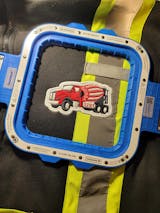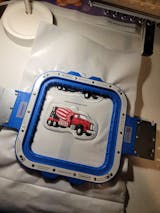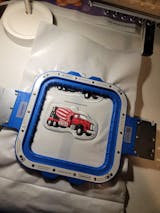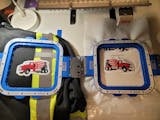1. Introduction: Understanding EM-1010 Investment Factors
Investing in an embroidery machine can define the next phase of your creative business or hobby. The Ricoma EM-1010 is a favorite for both beginners and experienced embroiderers. Beyond the sticker price, the real cost includes financing terms, package contents, and potential hidden fees. To boost ROI, accessories like sewtalent magnetic hoops streamline hooping, reduce waste, and smooth your workflow—an ideal pairing with the EM-1010.
In this guide, youll find a clear breakdown of pricing variables, financing paths, package inclusions, and long-term costs so you can make a confident, well-informed decision.
Table of Contents
- 1. Introduction: Understanding EM-1010 Investment Factors
- 2. Ricoma EM-1010 Pricing Breakdown (2024 Update)
- 3. Financing Options: $135$209/Month Payment Plans
- 4. Package Contents & Hidden Costs Revealed
- 5. Competitor Comparison: EM-1010 vs Industrial Machines
- 6. Long-Term Ownership Costs Analysis
- 7. Conclusion: Is the EM-1010 Worth the Investment?
- 8. FAQ: Top EM-1010 Cost Questions Answered
2. Ricoma EM-1010 Pricing Breakdown (2024 Update)
2.1 Base Price Variations: $5,495$9,990 Range Explained
The EM-1010s price varies by seller, package, and included extras.
Regional Pricing & Official Listings:
- Official listings often start around $7,995, with year-to-year shifts in availability and pricing.
- Some third-party sellers advertise prices as low as $5,495 due to regional promotions, currency differences, or stripped-down bundles.
| Feature | EM-1010 Base Model | EM-1010 Plus |
|---|---|---|
| Needles | 10 | 10 |
| Touchscreen | 7-inch LCD | 10-inch LCD |
| Embroidery Area | 12.2" x 8.3" (310 x 210 mm) | 12.2" x 8.3" |
| Included Accessories | 4 hoops, cap kit, tool kit, Chroma Luxe software | Similar, may include more |
Why the Price Range?
- Promotions and short-term bundles can temporarily lower upfront cost.
- Excluded accessories (e.g., cap frames or software) reduce the price on paper.
- Upgrades like the EM-1010 Plus add a premium.
Pro Tips:
- Confirm current pricing with Ricoma or an authorized distributor; third-party listings may be outdated or region-specific.
- Compare whats included; missing items can add costs later. Machine-specific add-ons such as ricoma embroidery hoops can materially change total price.
- Lifetime technical support and training can offset higher upfront spend by reducing long-term headaches.
2.2 Promotional Discounts & Seasonal Offers
Timing and vendor matter.
Official Promotions vs Third-Party Deals:
- Ricomas seasonal sales may include reduced prices or bundled extras like training, additional hoops, or software perks.
- Third-party deals may appear lower but can reflect pared-down packages or limited support/warranty.
Financing Specials:
- Some promotions feature 0% down or reduced rates.
- Ask for current financing details, as offers change.
Value-Added Accessories:
- Premium bundles sometimes include magnetic embroidery hoops. These can speed hooping, reduce operator fatigue, and maintain even fabric tension for fewer mistakes and higher productivity.
Action Step:
- Request a detailed quote listing every item. During major sales events, negotiate for extras.
3. Financing Options: $135$209/Month Payment Plans
3.1 Business vs Personal Loan Structures
The EM-1010 is accessible through flexible personal and business lending.
Financing Structures:
- Personal lending: Credit-score based; standard application required.
- Business lending: For established businesses; potentially better terms with a solid financial history.
Down Payments:
- A down payment (e.g., $2,000 on a $9,000 machine) lowers monthly payments and total interest.
| Model | Monthly Payment | Total Repayment | Term |
|---|---|---|---|
| EM-1010 Base (ricoma em 1010 price) | $159 | $9,540 | 60 months |
| EM-1010 Plus | ~$200 | ~$12,000 | 60 months |
| Multi-Head Models | Up to $305 | Varies | Varies |
Special Promotions:
- Some plans offer 0% down or reduced rates.
- Personal loans require a credit check; business loans require proof of operations.
What Real Users Say:
- Testimonials highlight manageable payments in the $135$209 range as new owners ramp up production.
Pro Tip:
- For exact terms, contact Ricoma or an authorized dealer.
3.2 ROI Case Study: Breaking Even with 4 Hoodies/Month
Lets make the math tangible.
The Hoodie Math:
- With a $135 monthly payment and hoodies priced at $40, selling four per month covers the note.
- This break-even is echoed in user experiences and simple ROI calculations.
Production Efficiency Metrics:
- Moving from outsourcing to in-house embroidery can save thousands per month, shorten turnaround, and unlock new revenue streams.
- A user-friendly interface, bundled training, and strong support reduce the learning curve so you can produce and sell quickly.
Key Takeaway:
- Modest monthly sales targets can make the EM-1010 self-sustaining in short order.
Next Steps:
- Calculate your break-even based on your pricing and sales goals.
- Include the value of time saved and the opportunities opened by producing in-house.
4. Package Contents & Hidden Costs Revealed
When you buy the EM-1010, youre purchasing a machine plus the ecosystem around it: accessories, software, and support. Heres whats typically included, whats not, and what to budget for.
4.1 Included Accessories: Hoops, Software, Training Value
Core Hardware & Accessories:
- Steel Stand: A sturdy, heavy-duty stand with built-in storage for stability and organization.
- Hoop Kit: Four hoops (2.8"x2", 4.3"x4.3", 7.5"x5.5", and 12.2"x8.2") cover common items, plus a 15.75" belt hoop for larger projects.
- Cap Embroidery System: Cap driver, frame, and a snap-in/snap-out cap station for hats and curved surfaces.
- Starter Kit: Assorted threads, needles, scissors, tweezers, oil, bobbins, and a toolbox.
If you need replacements or backups, ricoma hoops are widely available.
Software & Training:
- Chroma Inspire Subscription: 12 months of entry-level design and digitizing tools.
- Chroma Luxe Digitizing Software: Included for more advanced customization; some users also work with other platforms like Embrilliance for font management.
- Training & Support: Lifetime access to training materials, video tutorials, and customer support.
Whats Not in the Box?
- Magnetic Hoops: Many owners upgrade to magnetic hoops for faster, easier hooping on tricky or thick fabrics. Sewtalent hoops excel here with powerful magnetic clamping, industrial-grade durability, and ergonomic use.
Why Consider Upgrading to Sewtalent Magnetic Hoops?
- Durability: High-grade PPSU plastic and N50-grade magnets can last up to 40 times longer than standard plastic hoops.
- Efficiency: Reduce hooping time from minutes to seconds.
- Fabric Protection: Even tension means fewer marks and less waste.
- Compatibility: Designed to fit the EM-1010 and many commercial machines.
Bottom Line: The starter kit is robust, but premium magnetic hoops can quickly pay for themselves via time savings, fewer errors, and lower maintenance.
4.2 Unexpected Expenses: Taxes, Import Fees & Software Renewals
Sales Tax & Import Fees:
- Sales Tax: In California, plan for a 13.45% sales tax. On a $6,660 machine, thats $895+.
- Import Duties: Depending on location and where you buy, import fees may apply.
Software Renewal Costs:
- Chroma Inspire: After 12 months, renew to maintain design/digitizing access.
- Additional Tools: Some users add software like Embrilliance for specific workflows.
Consumables & Maintenance:
- Threads, needles, bobbins, oil, grease, and occasional parts add up over time.
Extended Warranty & Upgrades:
- Extended coverage isnt included by default; budget if you want extra protection.
- As volume grows, consider more hoops, specialty attachments, or premium magnetic hoops.
Quick Tip: Ask for a quote that includes taxes, fees, and renewals. Bake these into your ROI.
5. Competitor Comparison: EM-1010 vs Industrial Machines
How does the EM-1010 stack up against industrial models like Tajima and multi-head machines?
5.1 Value Proposition Against Tajima & Multi-Head Models
| Model | Price Range | Needles | Heads | Max Speed | Embroidery Area | Key Features |
|---|---|---|---|---|---|---|
| Ricoma EM-1010 | $5,495$9,990 | 10 | 1 | 1,000 SPM | 12.2" x 8.3" | 2206 cap system, 7" touchscreen, 20M memory |
| Tajima TMEZ-KC | High-end | 915 | 28 | 1,100 RPM | Up to 17.7" x 19.7" | Multi-head, industrial speed |
| Ricoma MT-1501 embroidery machine (comparison) | $14,995+ | 15/head | 2 | N/A | N/A | Dual-head, high volume |
Key Observations:
- Cost Efficiency: EM-1010 pricing is often 3050% lower than multi-head models.
- Scalability: Industrial setups target mass production; EM-1010 suits boutique runs and startups.
- Speed & Capacity: While Tajima can be faster and multi-head, 1,000 SPM covers most small-shop needs.
Technical Strengths of the EM-1010:
- Cap Embroidery: 2206 rotation makes hat stitching smooth and reliable.
- User-Friendly Interface: A 7" HD touchscreen and 20 million stitch memory keep work simple and efficient.
- Material Flexibility: From silk to denim; optional magnetic hoops help maintain even tension on tough fabrics.
Where Industrial Models Win:
- Volume: Multi-head machines handle multiple items at once to reduce per-unit costs.
- Complexity: More needles enable more colors and intricate designs without rethreading.
Cost-Benefit Tradeoffs:
| Factor | Ricoma EM-1010 | Tajima 15-Needle | Multi-Head Models |
|---|---|---|---|
| Initial Investment | Low ($5K$10K) | High ($15K+) | Very High ($15K+) |
| Production Speed | Moderate (1,000 SPM) | High (1,100 RPM) | Highest (Dual/8-head) |
| Design Complexity | Moderate (10 needles) | High (15 needles) | Very High (15+/head) |
| Target User | Startups, small shops | Industrial users | High-volume producers |
Sewtalent Hoop Compatibility:
Sewtalent magnetic hoops can fit many leading brands with the right bracket, letting you standardize your embroidery frame workflow even if you add or upgrade machines later.
Bottom Line: EM-1010 is a cost-effective, versatile workhorse for small shops and hobbyists; industrial models win on volume and speed but require higher upfront spend.
6. Long-Term Ownership Costs Analysis
6.1 Maintenance Schedule: Daily Oiling vs Monthly Greasing
Routine Maintenance:
- Daily Cleaning: Clear lint from the bobbin case every four hours of run time to prevent tension issues and thread breaks.
- Weekly Oiling: A drop or two on key moving parts (e.g., rotary case, black rail) keeps things smooth.
- Monthly Greasing: Lithium grease on high-wear areas reduces friction and extends life.
Cost Implications:
- Lubricants are minor costs compared to downtime.
- A few minutes of maintenance pays off in uptime and stitch quality.
Repair Costs & Durability:
- Common issues can include electrical faults, software glitches, and wear on needles or rotary hooks. Some fixes need professional service.
- EM-1010 remains cost-effective but may pause more often than heavy-duty industrial units designed for 24/7 use.
Sewtalent Magnetic Hoops: Reducing Physical Strain
- Operator Comfort: Traditional hoops can tire hands/wrists during volume runs. Magnetic hoops simplify clamping and ease strain.
- Efficiency: Faster hooping means more time stitching and fewer errors. Many owners adopt magnetic hoops for embroidery machines to boost throughput.
Upgrade Considerations:
- Scalability: The EM-1010 tops out at 10 needles and a 12.2" x 8.3" field; high-volume operations may need industrial options over time.
- Total Cost of Ownership: Regular care plus a lower upfront price makes the EM-1010 a strong small-business pick; industrial models trade higher price for lower failure rates under heavy loads.
| Cost Category | EM-1010 Costs | Industrial Model Costs |
|---|---|---|
| Initial Purchase | ~$6,660 | $10,000+ |
| Maintenance | Weekly oil, monthly grease | Less frequent lubrication |
| Repairs | Moderate (parts + labor) | Lower (fewer failures) |
| Upgrades | Limited (max 10 needles) | Scalable (15+ needles) |
Final Thought: Consistent daily care delivers years of reliable serviceespecially with ergonomic, durable accessories such as Sewtalent magnetic hoops.
7. Conclusion: Is the EM-1010 Worth the Investment?
For startups and solo shops, the EM-1010 blends affordability, flexibility, and pro-grade results. With financing as low as $135/month and a break-even of about four $40 hoodies, it can pay for itself quickly. Established businesses value it as a nimble secondary machine: not as fast as multi-head industrial units, but reliable, easy to learn, and straightforward to maintain.
The difference-maker is workflow. Pair the EM-1010 with fast, fabric-friendly magnetic hoops to cut hooping time, protect materials, and reduce operator fatigue. For those asking if Ricoma is a good embroidery machine, the EM-1010 proves to be a cost-effective, versatile workhorse.
8. FAQ: Top EM-1010 Cost Questions Answered
8.1 Q: Can I transfer the EM-1010 warranty if I sell my machine?
A: Policies vary by dealer and region. Confirm with Ricoma or your authorized distributor.
8.2 Q: Are there any tax deductions available for purchasing the EM-1010?
A: Many small businesses can deduct equipment purchases, depending on local laws and structure. Consult a tax professional.
8.3 Q: What are my options if I want to upgrade from the EM-1010 in the future?
A: Consider trade-in/resale or step up to larger multi-needle or multi-head machines as volume grows.
8.4 Q: Are there hidden costs beyond the sticker price?
A: Plan for sales tax, potential import duties, software renewals, consumables, and optional extended warranties/accessory upgrades.
8.5 Q: How steep is the learning curve for new users?
A: The interface and training resources are beginner-friendly, and many users find the transition manageable.
8.6 Q: Is the EM-1010 suitable for home and business use?
A: Yes. Compact, portable, and feature-rich, it suits hobbyists and small-business owners alike.







